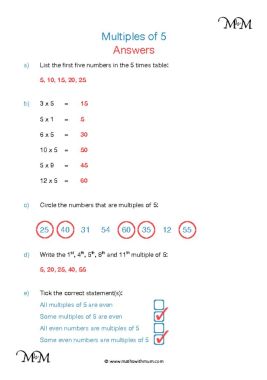What are Multiples of 5?
Multiples of 5 are numbers that can be divided by 5 exactly, leaving no remainder. They are made by multiplying any whole number by 5. For example, the third multiple of 5 is 15 because 3 × 5 = 15. The multiples of 5 always end in 0 or 5.
The first few multiples of 5 are simply the 5 times table.

The first multiples of 5 are:
- 1 × 5 = 5
- 2 × 5 = 10
- 3 × 5 = 15
- 4 × 5 = 20
- 5 × 5 = 25
- 6 × 5 = 30
- 7 × 5 = 35
- 8 × 5 = 40
- 9 × 5 = 45
- 10 × 5 = 50
- 11 × 5 = 55
- 12 × 5 = 60

Rule to Test if a Number is a Multiple of 5
Multiples of 5 only end in 5 or 0. If a number does not end in 5 or 0, it is not a multiple of 5. For example, 3470 is a multiple of 5 because it ends in a 0. The number 5526 is not a multiple of 5 because it ends in a 6.
Multiples of 10 are always multiples of 5. This is because 5 divides exactly into 10.
How to Find Multiples of 5
To find multiples of 5, multiply any whole number by 5. For example, the tenth multiple of 5 is 50 because 10 × 5 = 50. Alternatively, the multiples of 5 can be found by starting from 0 and counting up in fives.
Here we have the first multiples of 5 up to 100 shown on a chart.
We start at 0 and add on 5 each time to get from one multiple to the next.
0 + 5 = 5. Then 5 + 5 = 10. Then 10 + 5 = 15 and so on.

When teaching the multiples of 5, a number grid can be useful because we can easily see patterns in the position of the numbers. This helps us identify the multiples of 5. We can also see clearly that the multiples of 5 always end in a 5 or a 0.

What are the Multiples of 5 up to 100?
There are 20 multiples of 5 up to 100, which are:
5, 10, 15, 20, 25, 30, 35, 40, 45, 50, 55, 60, 65, 70, 75, 80, 85, 90, 95 and 100.
We can see that there is a difference of 5 between each multiple of 5.
Here is a longer list of the first 100 multiples of 5:
5, 10, 15, 20, 25, 30, 35, 40, 45, 50, 55, 60, 65, 70, 75, 80, 85, 90, 95, 100, 105, 110, 115, 120, 125, 130, 135, 140, 145, 150, 155, 160, 165, 170, 175, 180, 185, 190, 195, 200, 205, 210, 215, 220, 225, 230, 235, 240, 245, 250, 255, 260, 265, 270, 275, 280, 285, 290, 295, 300, 305, 310, 315, 320, 325, 330, 335, 340, 345, 350, 355, 360, 365, 370, 375, 380, 385, 390, 395, 400, 405, 410, 415, 420, 425, 430, 435, 440, 445, 450, 455, 460, 465, 470, 475, 480, 485, 490, 495 and 500.














